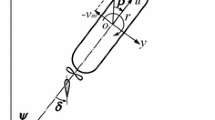Abstract
In this paper, hydrodynamic simulation of fish-like swimming for two types of aquatic animals including tuna fish and giant danio is presented. We employ an unsteady three-dimensional inviscid boundary element method including time stepping algorithm to capture the wake sheet and flow features around swimming fish in a straight course. At each time step, an unsteady Bernoulli equation was used to find the pressure distribution and thrust generated by the animal. To couple fluid solver with kinematic equations of flexible body, undulating motions of backbone were defined using a prescribed continuous function. Although the flexible motion mechanism controls the fish swimming but no structural model has been considered for the body, there is no fluid–solid interaction. To validate the model, we compare our results with the numerical work of Zhu et al. [1] and experimental results of Barrett et al. [2] and show that this methodology could be fast and reliable approach for the prediction of flexible propulsors.

















Similar content being viewed by others
References
Triantafyllou MS et al. (2002) Three-dimensional flow structures and vorticity control in fish-like swimming. J Fluid Mech 1–28
Barrett DS et al (1999) Drag reduction in fish-like locomotion. J Fluid Mech 392:183–212
Sfakiotakis M et al (1999) Review of fish swimming modes for aquatic locomotion. IEEE J Oceanic Eng 24(2):237–252
Gray J (1936) Studies in animal locomotion: the propulsive powers of the dolphin. J Exp Biol 13:192–199
Taylor GI (1952) Analysis of the swimming of long and narrow animals. Proc R Soc Lond 214(1117):158–183
Hancock GJ (1953) The self-propulsion of microscopic organisms through liquids. Proc R Soc Lond 217(1128):96–121
Gray J, Hancock GL (1955) The propulsion of Sea-Urchin spermatozoa. J Exp Biol 32:802–814
Lighthill M (1971) Large amplitude elongated-body theory of fish locomotion. Proc R Soc Lond 179:125–138
Wu T (1961) Swimming of waving plate. J Fluid Mech 10:321–344
Wu T (1971) Hydromechanics of swimming propulsion. Part 1: swimming of a two-dimensional flexible plate at variable forward speeds in an inviscid fluid. J Fluid Mech 46:337–355
Wu T (1971) Hydromechanics of swimming propulsion. Part 2: some optimum shape problems. J Fluid Mech 46:521–544
Wu T (1971) Hydromechanics of swimming propulsion. Part 3: swimming and optimum movements of slender fish with side fins. J Fluid Mech 46:545–568
Cheng J, Zhuang L, Tong B (1991) Analysis of swimming of three-dimensional waving plates. J Fluid Mech 232:341–355
Wolfgang MJ et al (1999) Near-body flow dynamics in swimming fish. J Exp Biol 202(Pt 17):2303–2327
Wolfgang M, Triantafyllou MS, Yue DKP (1999) Visualization of complex near-body transport processes in flexible-body propulsion. J Vis 2:143–151
Borazjani I, Sotiropoulos F (2008) Numerical investigation of the hydrodynamics of carangiform swimming in the transitional and inertial flow regimes. J Exp Biol 211(Pt 10):1541–1558
Borazjani I, Sotiropoulos F (2009) Numerical investigation of the hydrodynamics of anguilliform swimming in the transitional and inertial flow regimes. J Exp Biol 212(Pt 4):576–592
Pedley TJ, Hill SJ (1999) Large-amplitude undulatory fish swimming: fluid mechanics coupled to internal mechanics. J Exp Biol 202(Pt 23):3431–3438
Triantafyllou GS, Triantafyllou MS, Yue DKP (2000) Hydrodynamics of fish swimming. Annu Rev Fluid Mech 32:33–53
Stamhuis E, Videler JJ (1995) Quantitative flow analysis around aquatic animals using laser sheet particle image velocimetry. J Exp Biol 198:283–294
Anderson JM (1996) Vorticity control for efficient propulsion
Triantafyllou MS et al (1996) A new paradigm of propulsion and maneuvering for marine vehicles. Trans Soc Naval Archit Mar Eng 104:81–100
Muller U et al (1997) Fish foot prints: morphology and energetics of the wake behind a continuously swimming mullet (Chelon Labrosus Risso). J Exp Biol 200:2893–2906
Liu H, Wassenberg R, Kawachi K (1997) The three-dimensional hydrodynamics of tadpole swimming. J Exp Biol 200:2807–2819
Kang C-K et al (2011) Effects of flexibility on the aerodynamic performance of flapping wings. J Fluid Mech 689:32–74
Liu W, Xiao Q, Cheng F (2013) A bio-inspired study on tidal energy extraction with flexible flapping wings. Bioinspir Biomim 8(3):036011
Quinn DB, Lauder GV, Smits AJ (2014) Flexible propulsors in ground effect. Bioinspir Biomim 9(3):036008
Ghaffari SA et al (2015) Simulation of forced deformable bodies interacting with two-dimensional incompressible flows: application to fish-like swimming. Int J Heat Fluid Flow 51:88–109
Katz J, Plotkin A (1991) Low-speed aerodynamics. McGraw-Hill, Singapore
Hess JL (1972) Calculation of potential flow around arbitrary three dimensional lifting bodies. Report no. MDCJ 5679-01, McDonnell Douglas Corporation
Delhommeau G (1989) Amélioration des performances des codes de calcul de diffraction-radiation au premier ordre. Acte des 2èmes Journées de l’Hydrodynamiques, Nantes (France), pp 69–88
Hess JL, Smith AMO (1962) Calculation of non-lifting potential flow about arbitrary 3D bodies. Douglas Aircraft Report E.S.40622
Politis GK (2005) Unsteady rollup modeling for wake-adapted propellers using a time-stepping method. J Ship Res 216–231
Barrett DS (1996) Propulsive efficiency of a flexible hull underwater vehicle. Cambridge
Smith R, Wright J (2004) Simulation of RoboTuna fluid dynamics using a new incompressible ALE method. AIAA paper 2004–23:2347
Tai A (2009) Simulation of flow around deforming bodies with a Boundary Element Method. Department of Mechanical Engineering, University of Bath: UK
Techet AH, Hover FS, Triantafyllou MS (2003) Separation and turbulence control in biomimetic flows. Flow Turbul Combust 71(1–4):105–118
Anderson JM et al (1998) Oscillating foils of high propulsive efficiency. J Fluid Mech 360:41–72
Maxworthy T (1972) The structure and stability of vortex rings. J Fluid Mech 51(1):15–32
Author information
Authors and Affiliations
Corresponding author
Additional information
Technical Editor: Marcio S Carvalho.
Rights and permissions
About this article
Cite this article
Najafi, S., Abbaspour, M. Numerical study of propulsion performance in swimming fish using boundary element method. J Braz. Soc. Mech. Sci. Eng. 39, 443–455 (2017). https://doi.org/10.1007/s40430-016-0613-8
Received:
Accepted:
Published:
Issue Date:
DOI: https://doi.org/10.1007/s40430-016-0613-8




